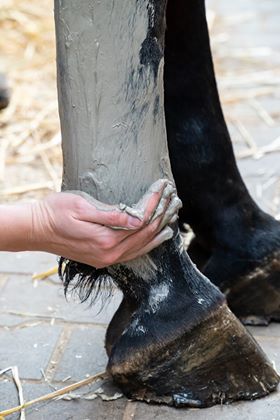Very appreciated by the riders, the clay for the horse, has many virtues which allow to look after certain diseases. Here are the main uses of this rock and its benefits.
What is clay and what form does it take?

Clay is a natural sedimentary rock extracted from the ground. The clays used in medicine are aluminum silicates. Clays can have several colors, depending on the degree of oxidation of the iron they contain. Generally speaking, green clay has the most beneficial properties for your horse. The structure of the clay is based on a large concentration of crystals that form layers. It is this “mille-feuilles” structure that makes this rock so popular with horsemen.
What are the virtues of clay for the horse?
Clay is known mainly for its astringent, absorbent, healing and covering properties.
- Astringent virtues: Clay helps to tighten tissues, so it can be applied to your horse’s limbs to promote the recovery of tendons and joints after intense effort. It can also be used in case of engorgements of the members of the horse. In this case, it is applied in the form of plaster.
- The absorbing virtues: Like a sponge, clay absorbs liquid, such as various secretions and exudates produced by wounds. It also absorbs intra-tissue inflammatory liquids, such as hematomas, muscle or tendon inflammations, edemas under the skin, etc. You can apply clay on a part of your horse’s body if it has suffered a trauma (shock, even a light blow). It also acts in the digestive system of the horse by absorbing the liquids in excess and thus restoring a good digestion to the horse.
- The adsorbent virtues: The clay can also retain on its surface particles (such as toxins, microbes, etc.). In case of diarrhea, it can adsorb for example bacteria and pathogenic viruses in the digestive system of the horse, provided that it is administered soon enough after the contamination.
- Healing virtues : Some varieties of clay stimulate blood coagulation and healing thanks to their high aluminum silicate content.
- Covering virtues: Clay can be used as an intestinal dressing and thus protect the mucous membrane of your horse’s stomach from potential aggressions, such as excessive secretions of gastric juices, acids or bile salts, microbes, anti-inflammatory drugs that can cause ulcers, etc. It will also prevent toxins or microbes from crossing the intestinal wall and entering the bloodstream.
How to use clay to treat horse diseases?
If you use the clay as a plaster, mix the powder with water. Wait 15 minutes to an hour to get a paste that is easier to apply. Apply it to the limbs or any other part of your horse’s body, to get as close to the skin as possible. Then smooth in the direction of the hair. You can leave the plaster to air dry, or if applied to the limbs, wrap it in cellophane or newspaper and cover with resting strips. The goal is to preserve the moisture of the clay, because it is only in this state that it acts. To rinse it off, simply hose it off with a brush.
If you wish to use it as a gastric dressing, it can already exist in the form of a paste or liquid to be administered orally. It can also be sold as a powder to be diluted in water.
Please note that there are some important precautions to be taken when using this product. In particular, never use a metal utensil to mix the clay with water, nor a metal container. Also, never reuse the clay twice, since it may have adsorbed toxic substances. Also, make sure to respect the recommended doses in order to avoid serious deficiencies in your horse.



